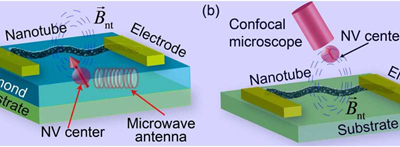
By carefully placing a tiny piece of diamond within a few nanometers of a carbon nanotube, and then sending an electric current through the nanotube, researchers have designed a device that could form the building blocks of quantum information processing

By carefully placing a tiny piece of diamond within a few nanometers of a carbon nanotube, and then sending an electric current through the nanotube, researchers have designed a device that could one day form the building blocks of quantum information processing systems.
In their recent study, they have shown that the electrified nanotube's mechanical vibrations couple to the magnetic (or spin) properties of defects in the diamond. This coupling allows for the quantum states of the nanotube and diamond to be transferred to each other as well as to a second diamond positioned several micrometers away.
The researchers, Peng-Bo Li et al., have published a paper on the new hybrid quantum device in a recent issue of Physical Review Letters.
Diamonds and carbon nanotubes, which are both carbon allotropes, each have their own unique properties that make building such a device possible. Diamond contains defects called nitrogen-vacancy centers that emit highly coherent bright red light. The defects' optical properties can be well-controlled so that they occupy one of two distinct states, which enables the defects to act as qubits. Carbon nanotubes, for their part, are well-known for their highly advantageous mechanical and electrical properties.
Both diamonds and carbon nanotubes have been widely studied as separate entities, but rarely together as an integrated device. Recently, related research has shown that the nitrogen-vacancy centers in diamond can be coupled to a mechanical resonator, such as a vibrating cantilever, so that the magnetic (spin) properties of the diamond are coupled to the mechanical motion of the resonator. However, the coupling strength in these devices has always been relatively weak.
The new work expands upon this idea by coupling a nitrogen-vacancy center in diamond to a carbon nanotube, which can be made to resonate by sending a 60-µA electric current through it. The researchers explain that the coupling between the nanotube and diamond defect occurs for the same reason that an electric current creates a nearby magnetic field, but on the quantum scale.
"This device corresponds to a quantum version of Oersted's classical experiment: a current-carrying wire creates a magnetic field around it, which will produce a force acting on a magnetic needle," Li, a physicist at RIKEN in Saitama, Japan, and Xi-an Jiaotong University in China, told us.
Due to the exceptional properties of the two carbon allotropes, the resulting hybrid device exhibits a magnetic coupling strength that is three orders of magnitude stronger than previous related devices. The interaction between the two components can also be tuned by controlling the electric current through the nanotube.
The researchers' proposal also shows that the quantum states of the nitrogen-vacancy center and the nanotube can be transferred to one another when they are coupled, as well as to a distant diamond's nitrogen-vacancy center that is coupled to the same vibration mode of the nanotube. In the future, the nitrogen-vacancy centers could be used as qubits, and the ability to quickly and efficiently control these qubits' states could form the basis of quantum information processing systems, and also be used as nanoscale sensors.
"This device could be used to mechanically address quantum logic gates based on electric spins and could serve as novel nanoscale sensors for detecting tiny pressure, temperature, electric, and magnetic-field changes in the physical and life sciences," Li said.
The researchers also found that this device behaves very similarly to cavity quantum electrodynamics (QED) devices, so that further improvements might be made by applying the wealth of knowledge on cavity QED to the new devices.